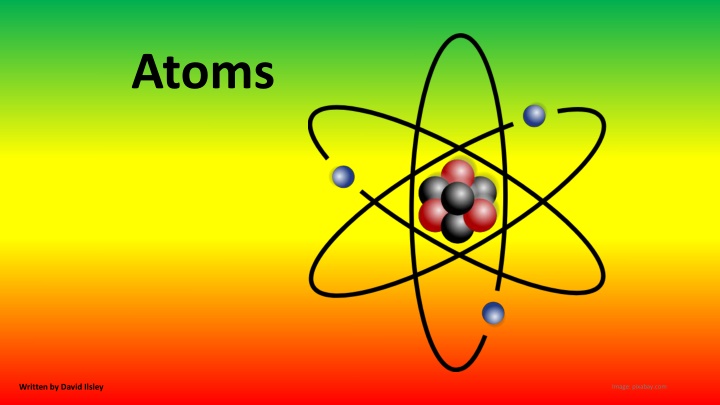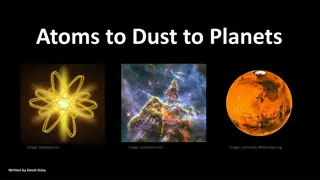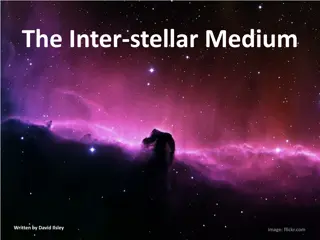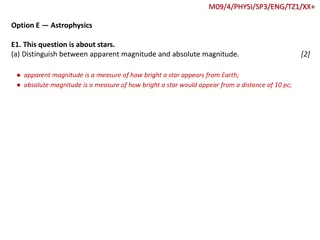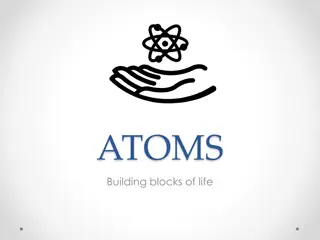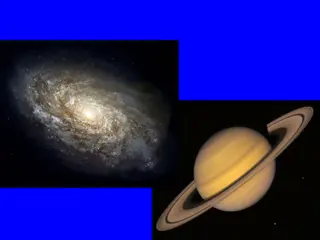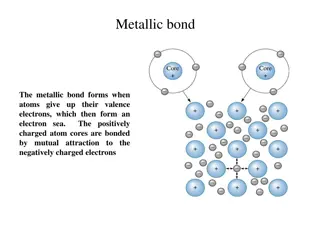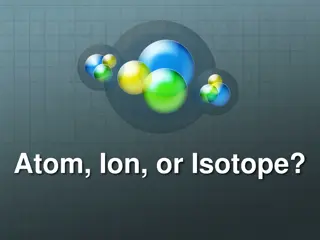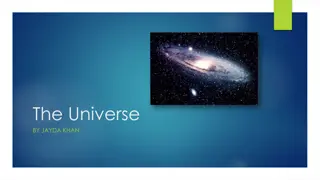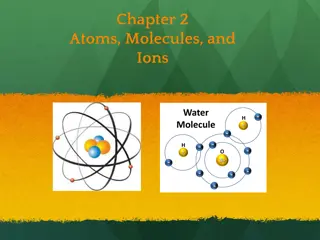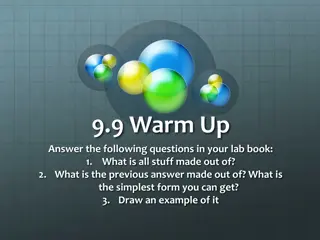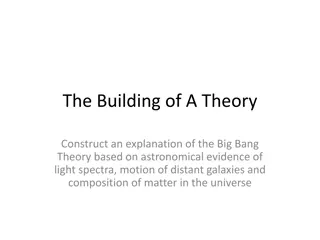The Journey of Atoms: From the Big Bang to Earth
The narrative explores the intriguing evolution of atoms from the Big Bang, where protons, neutrons, and electrons were born, to the formation of hydrogen and helium atoms. Over time, denser regions condensed to form stars, triggering nuclear fusion and creating heavier elements. This led to the existence of 94 naturally occurring atoms on Earth, each distinguished by its unique proton count. The composition and significance of elements such as hydrogen, iron, and gold are highlighted, showcasing how atoms play a fundamental role in shaping our world.
Download Presentation

Please find below an Image/Link to download the presentation.
The content on the website is provided AS IS for your information and personal use only. It may not be sold, licensed, or shared on other websites without obtaining consent from the author.If you encounter any issues during the download, it is possible that the publisher has removed the file from their server.
You are allowed to download the files provided on this website for personal or commercial use, subject to the condition that they are used lawfully. All files are the property of their respective owners.
The content on the website is provided AS IS for your information and personal use only. It may not be sold, licensed, or shared on other websites without obtaining consent from the author.
E N D
Presentation Transcript
Atoms Written by David Ilsley Image: pixabay.com
The Big Bang produced protons, neutrons and electrons (as well as photons, neutrinos, dark matter and dark energy). The protons, neutrons and electrons produced normal matter. The heat and pressure caused the neutrons to combine with protons to form nuclei consisting of two protons and two neutrons. A single protons is a hydrogen nucleus. Two protons and two neutrons make a helium nucleus. A few minutes after the Big Bang, we had hydrogen nuclei, helium nuclei and electrons. Image: commons.wikimedia.org
About 380 000 years later, the temperature got down to about 3000 K and the negatively charged electrons could attach themselves to the positively charged nuclei to form atoms: hydrogen atoms with one proton in the nucleus and one electron orbiting it and helium atoms with two protons and two neutrons in the nucleus and two electrons orbiting the nucleus. Image: commons.wikimedia.org
But eventually, the slightly denser regions of hydrogen-helium gas (along with dark matter) condensed under their own gravity to form stars. The intense heat and pressure in the cores of the stars caused the atoms to split into nuclei and electrons again and caused more hydrogen nuclei to combine to make helium nuclei. In the red giant and supernova phases of these stars, helium nuclei combined to make bigger nuclei like carbon and oxygen, silicon, iron and even bigger ones like gold, lead and uranium. And these were thrown off into space where they could combine with electrons to form new atoms. Image: rawpixel.com
There are 94 different naturally occurring atoms on Earth. Each kind of atom has a different number of protons (from 1 to 94). The number of protons determines what kind of atom it is, For example: if it has 1 proton, it is hydrogen; if it has 2 protons, it is helium; if it has 6 protons, it is carbon; if it has 26 protons, it is iron; if it has 79 protons, it is gold; and so on. Image: en.wikipedia.org
A substance made of just one kind of atom is called an element. So the element hydrogen consists of just hydrogen atoms; the element iron consists of just iron atoms, etc. Hydrogen is a gas at room temperature; Iron is a solid at room temperature; Mercury is a liquid at room temperature. So sometimes, instead of saying there are 94 different types of atom occurring naturally, we say there are 94 naturally occurring elements. Image: commons.wikimedia.org
Different atoms have different chemical properties. For instance, hydrogen will react (combine) with oxygen to form water molecules, but it won t react with helium; Iron will react with oxygen to form iron oxide (rust), but gold won t gold doesn t rust. It is these different chemical properties of the atoms that allow complex molecules to form, atoms to condense into dust and planets, and life to happen. Image: SnappyGoat.com
The chemical properties of atoms result from the number of electrons they have and the way these electrons are arranged. The number of electrons is always equal to the number of protons, so, indirectly, they result from the number of protons, but, more directly, they result from the number and arrangement of electrons. Image: denstoredanske.lex.dk
Electrons reside in different orbits around the nucleus. These different orbits have different sizes and different shapes and are called orbitals. Pauli s exclusion principal requires that no two electrons in an atom can occupy the same quantum state. Being in a particular orbital constitutes being in a particular quantum state. But having different spins also constitutes being in different quantum states. Electrons can have two spins spin up and spin down. So each orbital can hold two electrons one spin up and one spin down.
As mentioned, the different orbitals have different sizes and shapes. There are 7 sizes called Level 1, Level 2, . . . Level 7 And there are 4 shapes called Sublevels s, p, d and f. It s easy to remember the order of the levels: 1, 2, 3, 4, 5, 6, 7. It s less easy to remember the order of the sublevels: s, p, d, f. One way is to think about the electrons orbiting very fast and getting a speeding fine. Image: publicdomainpictures.net
The levels and sublevels can be arranged in a table like this. The numbers in brackets beside the sublevels show the number of orbitals in that sublevel at each level. Sublevel s (1) p (3) d (5) f (7) 1 1s 2 2s 2p Note that Level 1 has only 1 sublevel (s), Level 2 has 2 sublevels (s, p), Level 3 has 3 sublevels (s, p, d) and the rest of the levels have 4 sublevels (s, p, d, f). 3 3s 3p 3d Level 4 4s 4p 4d 4f 5 5s 5p 5d 5f 6 6s 6p 6d 6f In actual fact, Level 5 has 5 sublevels (s, p, d, f, g), Level 6 has 6 sublevels and so on. But sublevels beyond f are never occupied in unexcited atoms. 7 7s 7p 7d 7f
In the diagram, the energy of the orbitals increases down and to the right. Sublevel s (1) p (3) d (5) f (7) So Level 2 is higher energy than Level 1 and so on. 1 1s And Sublevel p is higher energy than Sublevel s and so on. 2 2s 2p 3 3s 3p 3d Electrons occupy the lowest-energy available orbital first. (Just like a ball on a slope will naturally move to the bottom of the slope (where energy is lowest). Level 4 4s 4p 4d 4f 5 5s 5p 5d 5f 6 6s 6p 6d 6f So, as more electrons are added to the atom, the top-left orbitals are filled up first. 7 7s 7p 7d 7f
Sublevel The order in which they are filled up is: s (1) P (3) d (5) f (7) 1s, 2s, 2p, 3s, 3p, 4s, 3d, 4p, 5s, 4d, 5p, 6s, 4f, 5d, 6p, 7s, 5f. 1 1s This is shown with the arrows on the diagram. 2 2s 2p 3 3s 3p 3d Level 4 4s 4p 4d 4f Orbitals with higher energy than 5f aren t used, because no nucleus can be big enough to require that many electrons. 5 5s 5p 5d 5f 6 6s 6p 6d 6f 7 7s 7p 7d 7f
The periodic table on the next slide shows which shell and subshell each new electron goes into.
1 H 2 He 1s 3 Li 4 Be 3 B 6 C 7 N 8 O 9 F 10 Ne 2s 2p 11 Na 12 Mg 3s 13 Al 14 Si 15 P 16 S 17 Cl 18 Ar 3p 19 K 20 Ca 21 Sc 22 TI 23 V 24 Cr 25 Mn 26 Fe 27 Co 28 Ni 29 Cu 30 Zn 31 Ga 32 Ge 33 As 34 Se 35 Br 36 Kr 4s 4p 3d 37 Rb 38 Sr 39 Y 40 Zr 41 Nb 42 Mo 43 Tc 44 Ru 45 Ro 46 Pd 47 Ag 48 Cd 49 In 50 Sn 51Sb 52 Te 53 I 54 Xe 4d 5s 5p 55 Cs 56 Ba 57 La 72 Hf 73 Ta 74 W 75 Re 76 Os 77 Ir 78 Pt 79 Au 80 Hg 80 Tl 82 Pb 83 Bi 84 Po 6p 85 At 86 Rn 6s 5d 87 Fr 88 Ra 89 Ac 7s 58 Ce 59 Pr 60 Nd 61 Pm 62 Sm 63 Eu 64 Gd 65 Tb 66 Dy 67 Ho 68 Er 68 Tm 70 Yb 71 Lu 4f 90 Th 91 Pa 92 U 93 Np 94 Pu 5f
The periodic table on the next slide shows the shape of the orbitals. For each element, it shows the shape of the orbital of the last electron added. For heavy elements like Lead with atomic number 82 (i.e. 82 protons), each atom contains 82 electrons, one with each of the orbitals shown in boxes 1 to 82. In accordance with quantum theory, each picture shows the probability that the electron will be at each position around the nucleus the brighter the colour the higher the probability.
Atoms in which the available s and p subshells are full tend to be very stable and so tend not to react with other atoms. Theses are the elements, helium, neon, argon, krypton, xenon and radon. These are called the inert gases. Because they don t form molecules, they stay as gases, even at very low temperatures. Image: pixabay.com
Elements with just a small number of electrons in their outer s and p subshells, like sodium, magnesium, potassium etc, tend to lose these electrons easily, becoming positively charged ions and thus being attracted to and reacting with negatively charged ions. Elements with nearly full s and p subshells tend to take in other electrons to complete the shells, thus becoming negatively charged ions and reacting with positive ions. Sodium ions react with chlorine ions very readily to form sodium chloride, table salt. This is called ionic bonding . Image: commons.wikimedia.org
Atoms with incomplete s and p subshells can also share electrons to complete their shells, thus forming molecules with covalent bonds. Carbon, oxygen, hydrogen, nitrogen etc. bond covalently to produce most of the molecules that our bodies are made of. Some of these molecules, like proteins and DNA, can be very large and complex. Image: commons.wikimedia.org
Model of a small part of a DNA molecule. The different colours represent different atoms: hydrogen, carbon, oxygen etc.
